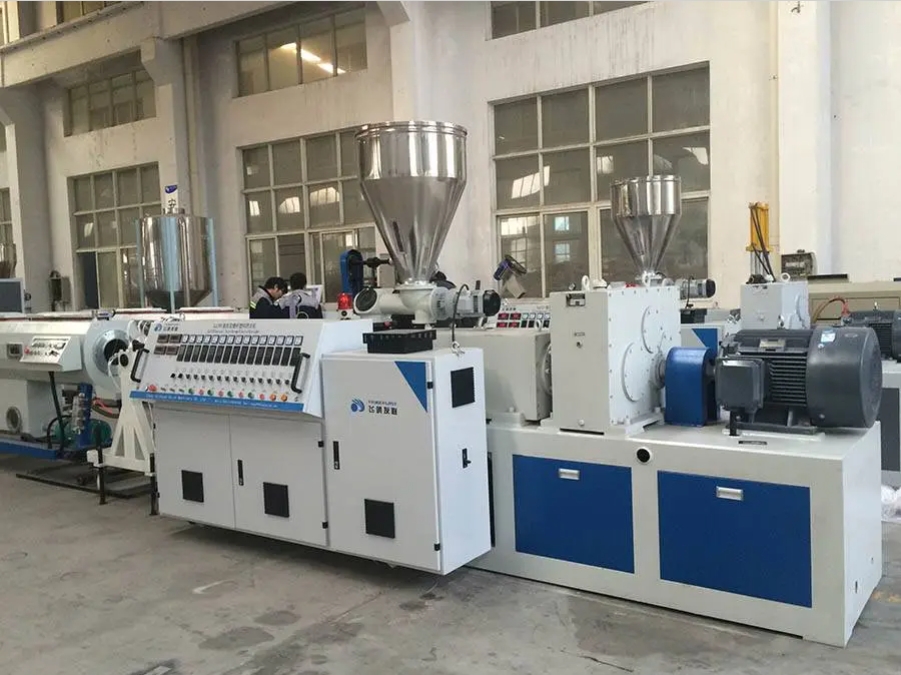A conical twin screw extruder is a type of twin screw extruder that has two screws arranged in a conical shape, tapering towards the discharge end of the extruder. This design provides a gradual reduction in the screw channel volume, resulting in increased pressure and improved compounding. A conical twin screw extruder is mainly composed of barrel screw, gear transmission system, quantitative feeding, vacuum exhaust, heating, cooling and electrical control components.
A conical twin screw extruder is suitable for producing PVC products from mixed powder. PVC is a thermoplastic polymer that has a wide range of applications in various industries, such as construction, packaging, electrical, automotive, and medical. However, PVC is not compatible with many other polymers and additives, and requires special processing techniques to achieve the desired properties and performance. A conical twin screw extruder can provide the necessary mixing, melting, devolatilization, and homogenization of PVC and its additives in a continuous and efficient manner.
A conical twin screw extruder is also special equipment for WPC powder extrusion. WPC stands for wood-plastic composite, which is a material that combines wood fibers or wood flour with thermoplastic polymers, such as PVC, PE, PP, or PLA. WPC has the advantages of both wood and plastic, such as high strength, durability, weather resistance, and recyclability. A conical twin screw extruder can process WPC powder with high output, stable running, and long service life.
With different mould and downstream equipment, a conical twin screw extruder can produce various PVC and WPC products, such as pipes, ceilings, window profiles, sheet, decking, and granules. These products have different shapes, sizes, and functions, and can meet the diverse needs of customers and markets.
Process Description
The process of conical twin screw extrusion can be divided into four main stages: feeding, melting, devolatilization, and shaping.
Feeding
The first stage of conical twin screw extrusion is feeding. In this stage, the raw materials, such as PVC or WPC powder, and other additives, such as stabilizers, lubricants, fillers, pigments, and modifiers, are metered and fed into the extruder by different feeding devices, such as screw augers, vibratory trays, weigh-belts, and injection pumps. The feeding rate and accuracy are important factors that affect the quality and consistency of the final products. The raw materials can be pre-mixed and fed, or separately and sequentially metered into the extruder, depending on the formulation and the desired properties of the products.
Melting
The second stage of conical twin screw extrusion is melting. In this stage, the raw materials are conveyed, compressed, and heated by the rotating screws and the barrel heaters, and transformed from solid to liquid state. The melting process involves both thermal and mechanical energy input, and is influenced by the screw speed, screw configuration, barrel temperature, and material properties. The melting process is also critical for the dispersion and distribution of the additives in the polymer matrix, and the initiation of the chemical reactions, such as cross-linking, grafting, or degradation, that may occur in the melt. The melting process must be controlled carefully to avoid overheating, over-shearing, or under-melting of the materials, which may result in poor product quality and performance.
Devolatilization
The third stage of conical twin screw extrusion is devolatilization. In this stage, the volatile components, such as moisture, air, monomers, solvents, and decomposition products, are removed from the melt by applying vacuum at the vent ports along the extruder barrel. The devolatilization process is essential for improving the product quality and stability, as well as reducing the environmental impact and health hazards of the extrusion process. The devolatilization process depends on the screw design, vacuum level, melt viscosity, and material characteristics. The devolatilization process must be optimized to achieve sufficient removal of the volatiles without causing excessive foaming, vent flooding, or melt degradation.
Shaping
The fourth and final stage of conical twin screw extrusion is shaping. In this stage, the melt is extruded through a die or a mould that determines the shape and size of the product. The die or mould can be designed to produce various products, such as pipes, profiles, sheet, film, or granules. The shaping process is influenced by the die geometry, die pressure, die temperature, and melt rheology. The shaping process must be adjusted to achieve uniform and smooth extrudates without defects, such as die swell, melt fracture, or dimensional instability. After the shaping process, the extrudates are cooled, cut, and collected by the downstream equipment, such as calibrators, haul-offs, cutters, and winders.
Conclusion
A conical twin screw extruder is a versatile and efficient device for producing PVC and WPC products from mixed powder. It can provide the necessary functions of feeding, melting, devolatilization, and shaping in a continuous and controlled manner. It can also produce various products with different shapes, sizes, and functions, by using different mould and downstream equipment. A conical twin screw extruder has advantages of good compounding, large output, stable running, and long service life, and can meet the diverse needs of customers and markets.
For further information or inquiries, please contact us:
Email: hanzyan179@gmail.com
Post time: Jan-24-2024






